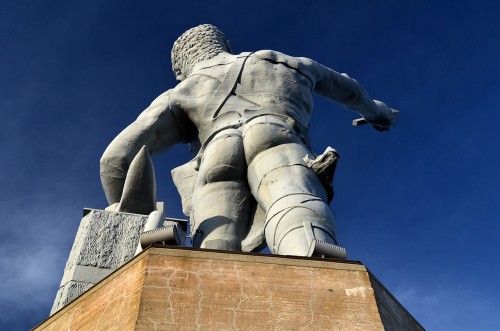 Road Warriorette Anne and I were rocketing up the Interstate through Alabama on a dark night. She was straining her eyes to catch a glimpse of Birmingham’s bare-bottomed statue of Vulcan perched high atop the Red Mountain overlooking the former steel town.
Road Warriorette Anne and I were rocketing up the Interstate through Alabama on a dark night. She was straining her eyes to catch a glimpse of Birmingham’s bare-bottomed statue of Vulcan perched high atop the Red Mountain overlooking the former steel town.
Anne, despite having written a book called Kiss and Tell: Secrets of Sexual Desire from Women 15 to 97, was not looking for any prurient reasons; she was looking to see if the Vulcan’s torch was green or red; the latter meaning that there had been a road fatality in the past 24 hours. (More about that later.)
Alas, she saw neither the bare bottom, the lighted torch, or, truth be told, ANYTHING about Vulcan. We kept on truckin’, with her swearing that I had been pulling her leg.
As always, clicking on a photo will make it larger.
Moon Over Homewood
The statue’s naked buttocks have been source of humor for many years. Chick Churn and the Chillydippers recorded a novelty song, Moon Over Homewood, that refers to the fact that the statue “moons” the neighboring suburb of Homewood, Alabama. If you play the song, it will soon become obvious why you’ve never heard it before.
Vulcan’s background
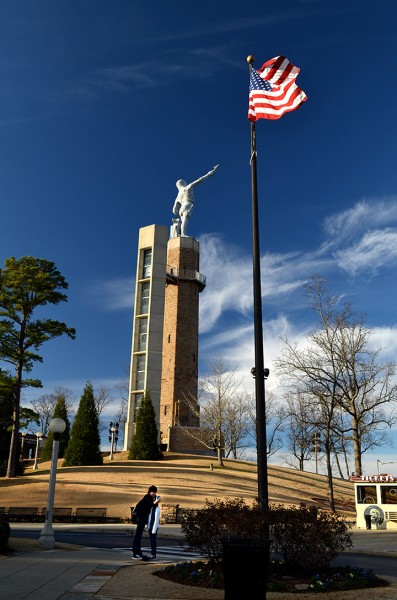 I swiped the following from the Vulcan Park & Museum’s website:
I swiped the following from the Vulcan Park & Museum’s website:
In ancient Rome, Vulcan was the god of the forge, a shop with a furnace where metal is heated and hammered out into useful items. His father was Jupiter, the supreme ruler of the universe, and his mother, Juno. Unlike all the other gods and goddesses, who were perfectly beautiful, Vulcan was ugly and lame. He was thrown from Mount Olympus, the home of the gods. After falling for an entire day, he landed on the island of Lemnos in the Aegean Sea and worked as a blacksmith, using a volcano as his forge. The one-eyed Cyclopes were his helpers. He made weapons and armor for all the gods but was kindly and peaceful himself. Vulcan married Venus, goddess of Love and Beauty.
Birmingham in the distance
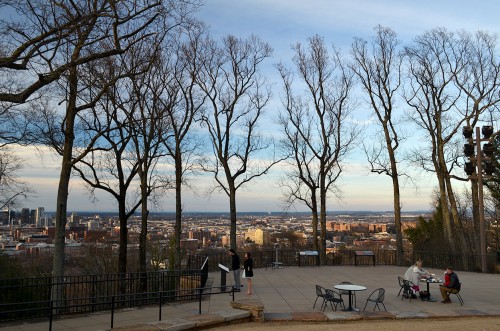 But what does an ancient god have to do with a modern city?
But what does an ancient god have to do with a modern city?
Birmingham was founded in 1871. The area where the city grew is unique because it contains coal, iron ore and limestone, the raw materials for making iron and steel. Birmingham’s founders knew this would be a good place to build an industrial city. By 1900, Birmingham was called the “Magic City” because it grew so quickly. [It was also known as “Smoke City” on the CB because of the way the valley held the industrial fog in it.]
A city of the industrial South
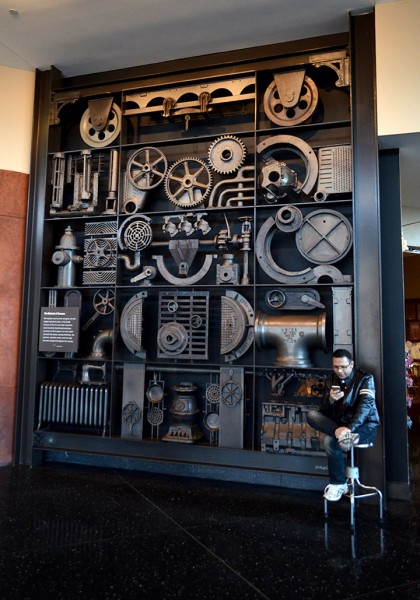 City leaders wanted to advertise Birmingham and the state of Alabama to the world by entering an exhibit in the St. Louis World’s Fair. James A. MacKnight, the manager of the Alabama State Fair, decided a statue of Vulcan would best highlight the area’s growing industrial abilities. MacKnight searched for a sculptor, and finally found Giuseppe Moretti, an Italian immigrant who had come to New York City in 1888 and was becoming well known for creating large and beautiful statues.
City leaders wanted to advertise Birmingham and the state of Alabama to the world by entering an exhibit in the St. Louis World’s Fair. James A. MacKnight, the manager of the Alabama State Fair, decided a statue of Vulcan would best highlight the area’s growing industrial abilities. MacKnight searched for a sculptor, and finally found Giuseppe Moretti, an Italian immigrant who had come to New York City in 1888 and was becoming well known for creating large and beautiful statues.
This is not a small statue
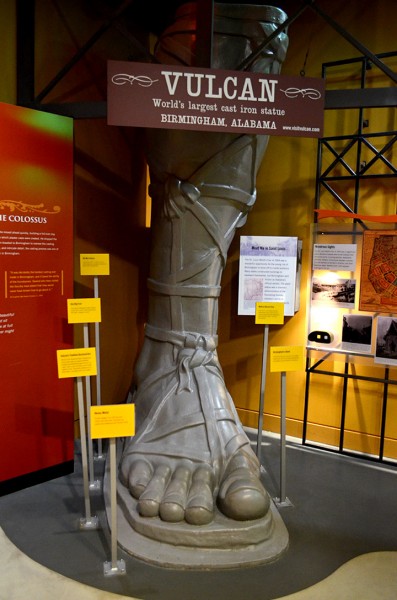 With the World’s Fair opening less than five months away, Moretti wasted no time getting to work. He made a two-foot tall clay model. Next, he made a full-size clay model, using a large, abandoned church in New Jersey as his studio. The clay was applied over a wooden form. Because Vulcan was so big, the wooden form and the clay model were actually in two pieces – the top and bottom half of Vulcan. Moretti then used this full-size model to create plaster molds, which were shipped back to Birmingham. Birmingham Steel and Iron Company used the molds to cast the statue in iron. The casting was done one piece (21 pieces) at a time.
With the World’s Fair opening less than five months away, Moretti wasted no time getting to work. He made a two-foot tall clay model. Next, he made a full-size clay model, using a large, abandoned church in New Jersey as his studio. The clay was applied over a wooden form. Because Vulcan was so big, the wooden form and the clay model were actually in two pieces – the top and bottom half of Vulcan. Moretti then used this full-size model to create plaster molds, which were shipped back to Birmingham. Birmingham Steel and Iron Company used the molds to cast the statue in iron. The casting was done one piece (21 pieces) at a time.
Statue was assembled in St. Louis
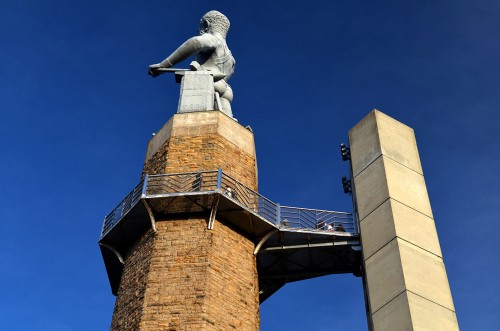 As the statue’s pieces were cast, they were sent to St. Louis to be assembled. The statue of Vulcan, with his dark, burnished, metallic finish, was dedicated on June 7, 1904, in the Palace of Mines and Metallurgy at the World’s Fair. Moretti sculpted Vulcan standing with his anvil at his left side. In his left hand, he held his hammer. He held his right hand high in the air, admiring a spear he had just finished making in his forge. The statue proved to be a very popular exhibit and won the Grand Prize, as well as medals for the sculptor and foundry.
As the statue’s pieces were cast, they were sent to St. Louis to be assembled. The statue of Vulcan, with his dark, burnished, metallic finish, was dedicated on June 7, 1904, in the Palace of Mines and Metallurgy at the World’s Fair. Moretti sculpted Vulcan standing with his anvil at his left side. In his left hand, he held his hammer. He held his right hand high in the air, admiring a spear he had just finished making in his forge. The statue proved to be a very popular exhibit and won the Grand Prize, as well as medals for the sculptor and foundry.
Returned to suffer indignities
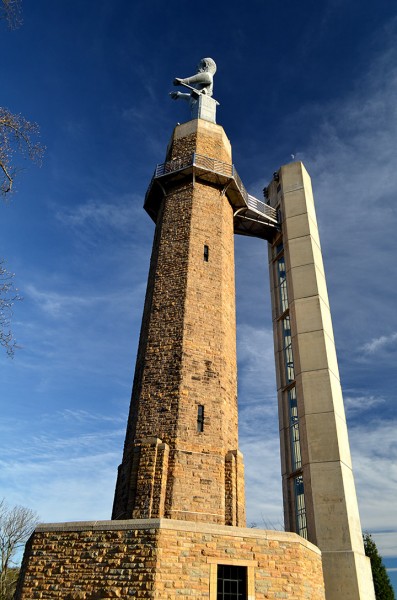 In 1905, when the World’s Fair had ended, Vulcan was taken apart and brought by train back to Birmingham. His pieces lay atop Red Mountain while city leaders tried to decide where to put him. Some wanted him in Capitol Park, now called Linn Park, in downtown Birmingham. Others thought he should stand atop Red Mountain. After a year and a half, he wound up at the Alabama State Fairgrounds. Although it was to be a temporary home, Vulcan stayed there for almost thirty years. Moretti was not there to help, and Vulcan wasn’t put together correctly. He couldn’t hold his hammer because his left hand was turned the wrong way. His left arm had to be supported by a timber. His right hand was put on backwards, so he could not hold his spear. Merchants began to use him for advertising, and over the years he held various objects, such as a giant ice cream cone, a pickle sign and a Coke bottle. Later he wore a giant pair of Liberty overalls. In the 1930s he was repainted in flesh tones. Also, people only saw him for the few weeks the fair was open each year.
In 1905, when the World’s Fair had ended, Vulcan was taken apart and brought by train back to Birmingham. His pieces lay atop Red Mountain while city leaders tried to decide where to put him. Some wanted him in Capitol Park, now called Linn Park, in downtown Birmingham. Others thought he should stand atop Red Mountain. After a year and a half, he wound up at the Alabama State Fairgrounds. Although it was to be a temporary home, Vulcan stayed there for almost thirty years. Moretti was not there to help, and Vulcan wasn’t put together correctly. He couldn’t hold his hammer because his left hand was turned the wrong way. His left arm had to be supported by a timber. His right hand was put on backwards, so he could not hold his spear. Merchants began to use him for advertising, and over the years he held various objects, such as a giant ice cream cone, a pickle sign and a Coke bottle. Later he wore a giant pair of Liberty overalls. In the 1930s he was repainted in flesh tones. Also, people only saw him for the few weeks the fair was open each year.
Moved to Red Mountain
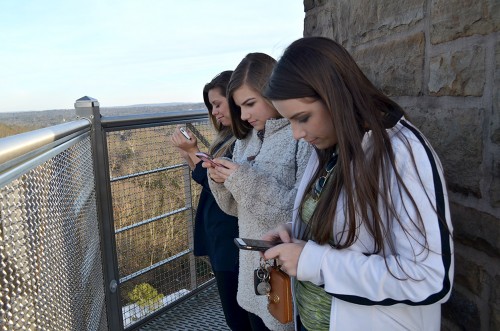 People began to discuss bringing back Vulcan’s dignity and moving him to a park to be created especially for him atop Red Mountain. It took years for the new park to be built, partly because of the hard economic times during the years of the Great Depression. During the Depression, the United States government formed the Works Progress Administration. Also known as the WPA, this agency provided unemployed people with jobs, such as constructing trails and buildings in public parks. The WPA agreed to help get the land ready for the new park and to construct a museum as well as a beautiful stone pedestal for the statue. In May 1939, Vulcan, now painted with aluminum paint, was finally in his new home in Vulcan Park, atop Red Mountain. The hollow statue was partially filled with concrete to help anchor it in place.
People began to discuss bringing back Vulcan’s dignity and moving him to a park to be created especially for him atop Red Mountain. It took years for the new park to be built, partly because of the hard economic times during the years of the Great Depression. During the Depression, the United States government formed the Works Progress Administration. Also known as the WPA, this agency provided unemployed people with jobs, such as constructing trails and buildings in public parks. The WPA agreed to help get the land ready for the new park and to construct a museum as well as a beautiful stone pedestal for the statue. In May 1939, Vulcan, now painted with aluminum paint, was finally in his new home in Vulcan Park, atop Red Mountain. The hollow statue was partially filled with concrete to help anchor it in place.
Neon torch was removed in the 1999 restoration
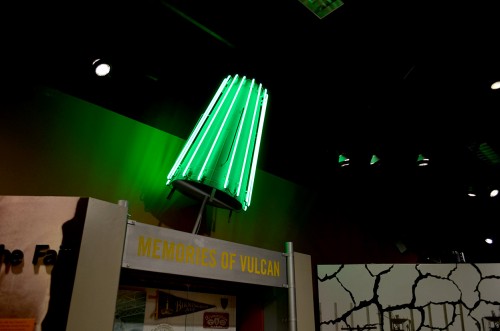 In 1946, some safety-minded citizens decided Vulcan should remind everyone to drive carefully. Instead of his newly forged spear, he now held a cone-shaped, lighted beacon. This signal glowed green on days no one was killed in an auto accident and red on days when there was a fatality.
In 1946, some safety-minded citizens decided Vulcan should remind everyone to drive carefully. Instead of his newly forged spear, he now held a cone-shaped, lighted beacon. This signal glowed green on days no one was killed in an auto accident and red on days when there was a fatality.
In the late 1960s, people began to feel Vulcan and his park should be further “modernized” for Birmingham’s one-hundredth birthday in 1971. This idea led to the addition of a huge marble-clad enclosure and observation deck, which covered up the original stone pedestal. These additions made it difficult for visitors to see Vulcan from below and hid the beautiful stone.
During this time, the statue was also painted the color of iron ore. Over the years, the concrete poured inside Vulcan in the 1930s as an anchor began to cause problems. It also expanded and contracted at a different rate from the cast iron. Since Vulcan did not have a top to his head, rain poured into the statue. These factors caused the statue to develop cracks. In 1999, Vulcan had to be removed from his pedestal.
Vulcan back on top of world
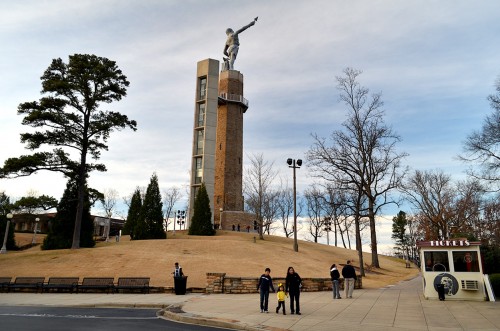 Vulcan Park Foundation was formed in 1999 to raise money to restore Vulcan to his original glory. The pieces of Vulcan were sent to Robinson Iron and Steel who repaired (and in some cases recast) the statue – using original drawings from the artist Moretti. Vulcan is now painted gray – thought to be his original color. In 2003, Birmingham watched with anticipation as each piece of Vulcan was lifted onto the restored original pedestal. That park reopened to the public in 2004. Birmingham is glad to have Vulcan back in his rightful place on top of Red Mountain.
Vulcan Park Foundation was formed in 1999 to raise money to restore Vulcan to his original glory. The pieces of Vulcan were sent to Robinson Iron and Steel who repaired (and in some cases recast) the statue – using original drawings from the artist Moretti. Vulcan is now painted gray – thought to be his original color. In 2003, Birmingham watched with anticipation as each piece of Vulcan was lifted onto the restored original pedestal. That park reopened to the public in 2004. Birmingham is glad to have Vulcan back in his rightful place on top of Red Mountain.
